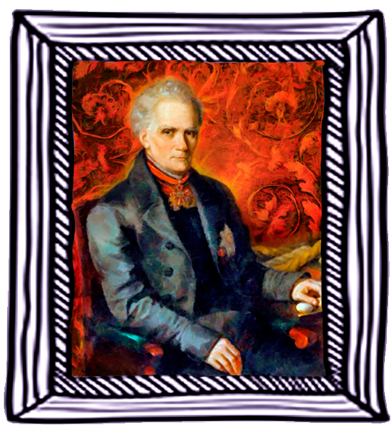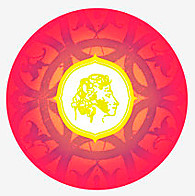English
Bibliographic information

Alexei Fedorovich Rebrov was born on March 5,1776 in Moscow.
A.F. Rebrov was leader of the Caucasian nobility, first settler and builder of the cities of Pyatigorsk and Kislovodsk, ethnographer, and historian of the Caucasian Mineral Waters. His name and destiny are connected with the history of industrialization and development of the North Caucasus. Alexei Rebrov was highly valued by his contemporaries, especially his contribution to the development of sericulture, for which he received 5 gold medals. His silk was famous as the best in Europe, for which Rebrov was awarded the Diploma of the French Royal Society of Sericulture, and in 1851 Rebrov received the Diploma for the best silk at The Great Exhibition of the Works of Industry of All Nations in London. Rebrov is also known as the winemaker of the imperial court, patron and a reformer - educator.Rebrov was a full member of many societies: from1831 - the Imperial Moscow Society of Agriculture, from 1834 the Imperial Moscow Society of Naturalists, 1851 the Imperial Free Economic Society and the Imperial Russian Geographical Society, and others. On the 20th of December 1850, a solemn meeting of the Moscow Society of Agriculture decided to place in the hall of meetings of the Russian Academy of Sciences a portrait of A.F. Rebrov as the first to cultivate the silkworm in Russia. Currently, the portrait is kept in the State Historical Museum.
Caucasian resorts owe Rebrov the fact that he made the rules for the organization of Caucasian mineral waters in an economic manner. So here there was a building commission, which has been engaged in the improvement of the resort area for more than twenty years. Alexei Rebrov himself became one of the first settlers in the beginning of building, with the residential buildings of the Konstantinogorsk fortress on the Hot Waters (now - the city of Pyatigorsk). In 1810 Rebrov (on the status of privileges, as the leader of the Caucasian nobility) built his first manor on the spur of Mashuk mountain near the mineral hot springs. In 1820, by order of General A.P. Ermolova, the collegiate adviser Aleksei Rebrov was officially assigned the best plot of land of 2,140 square meters - 1,000 square fathoms (25x40 sarcas) on a new plan in the northern quarter of the Hot Waters (as the city of Pyatigorsk was called until 1830) in order to legalize the construction of his 1810 estate.

The only image of the first Russian farmstead in the Konstantinogorsk fortress on the Hot Waters can be seen in the drawing of the architect Giuseppe Bernardazzi, Restoration and the View of the City of Pyatigorsk (1839).
In the background of the lithography on the right is a one-story building, with five windows facing the viewer. Behind it you can see the roof of the wing and part of the courtyard of the estate of Rebrov, the built up district with new buildings.

The painting depicts a solemn dinner for 18 people, given by the State Councilor A.F. Rebrov in honor of the emperor of the Russian Empire, Nicholas I and his heir, Tsarevich Alexander II Rebrov took a great part in the creation of the famous Kislovodsk health resort park.
In the creation of gardens and parks in Pyatigorsk, seedlings were also used from the farm estate of Rebrov in the village of Maslovka in the Stavropol Territory, where he had more than 400 serfs. "As an economist and administrator, Rebrov can be compared with the most outstanding people in Europe, he has such knowledge in matters of industrialization that do not even contain special books," wrote the French traveler Adel Ommer de Gell, who visited the Rebrov Manor in Pyatigorsk in the year 1841.

The Manor of Rebrov. Pyatigorsk. Figure Zichy to the novel by M. Lermontov "Hero of Our Time"
In accordance with the registration data of the state register on the setting of the historical monument "The Manor of Rebrov, where Alexander Pushkin visited", the state registration and protection means that the monument is located in the old part of the city. The time of construction is the beginning of the 19th century. The building is of one storey, the corner building is at the
intersection of Karl Marx and Anisimov Street (in the Tsar's time - Noble and Elizavetinskaya streets). The estate also includes two other buildings of the same period.

1830 year. Manor of Rebrov on the plan of the city of Pyatigorsk - No. 21 (highlighted in red)
In fact, from the real historical Renaissance manor, only a residential stone wing (letter A) has been preserved, where the private museum "Pushkin House in the Caucasus" and courtyard buildings - stone stables, seriously reconstructed over the past years into residential apartments. To date, at Pyatigorsk, at No. 6 Karl Marx street, there is a nine-apartment building consisting of several buildings, including: A - the date of construction of the beginning of the 19th century, in accordance with the scientific and project documentation "Natural Research. Correction of the historical and architectural reference plan of the Project for Protection of Historical and Cultural Monuments of the City of Pyatigorsk, developed by the architectural and restoration workshop of Semenova (2007), is defined as a monument of history and culture "The Manor of Rebrov, where Alexander Pushkin was in 1820"; B - the possible date of construction is the middle to end of the 19th century, in accordance with the specified project documentation attributed to the objects of the ordinary historical and architectural environment. The remaining buildings (residential buildings, garages, warehouses) were made in different years of construction on the territory of the Rebrov manor in the late 20th and early 21st centuries.

Picture V.P. Vasina The Manor of Rebrov. Pyatigorsk. 1976

The Manor of Rebrov. Private Museum "Pushkin House in the Caucasus." Pyatigorsk. 2017.
In the bibliographic sources there are references to the fact that on his first visit to the Hot Waters in 1820, the great poet Alexander Pushkin lived at the Rebrov Manor. It was in the Pyatigorsk mansion of the leader of the Caucasian nobility, Alexei Rebrov, that he rented premises for a month's residence (from June 6 to July 3, 1820), for Colonel Alexander Raevsky his father, brother, two sisters and servants. As the hero of the battle of Borodino of the Patriotic War of 1812 with Napoleon, the venerable General NN. Raevsky was taken around the Caucasus by the 21-year-old Alexander Pushkin. His friend Nikolai Raevsky, Jr. had found Pushkin sick in the city of Yekaterinoslav (now the city of Dnepropetrovsk, Ukraine) and persuaded his father to take him with him to the Hot Waters of the Caucasus. Young Pushkin quickly recovered in Pyatigorsk, so he not only admired the views of the mountains, but more than once conquered their peaks, calling the five- headed Mount Beshtau his Parnassus. It was in Pyatigorsk that Pushkin conceived the idea to write the poem "The Prisoner of the Caucasus", which in 1821 brought him worldwide fame.
Early each morning Pushkin rose to bathe in a hot spring with the children of General Raevsky, on the steep stone paths to the yet-enclosed abyss with the lake "Failure" on Mount Mashuk. Evenings were spent in conversation and philosophical discussions with Alexander Raevsky on the banks of the Podkumka, or together with the younger Nikolai Rayevsky, reading Byron, or with the daughter of General Rayevsky, the fifteen-year-old Maria, who gave the young poet lessons in English. Rebrov, as an official at large, was well acquainted with Patersen, head of the Scottish mission of the Edinburgh Order in the settlement of Karras, located at the foot of Mount Beshtau near Hot Waters (Pyatigorsk). To all arriving foreign guests, Rebrov arranged a reception in his Pyatigorsk mansion, which became not only a reception residence, but also a hotel for close friends of Rebrov. The archive retained the supervisory documents confirming the relocation of A.S. Pushkin and his residence in the estate of Rebrov: Arrived on the Hot Waters, Pushkin met with the official of the British mission in Persia, D. Willock, who was supervised. Major Krasovsky, supervising in Pyatigorsk, reported to his superiors: "... the English clerk Willock, with the Persian interpreter who was with him, arrived on June 20, 1820, to the Hot Waters Alexander Pushkin got acquainted with Willock in the estate of A.F. Rebrov, where the Englishman came twice. "
Rebrov hosted many guests at his estate, including the author of The Secret Doctrine, Elena Blavatsky, who ended her journey in London. As a result, the funds acquired in the estate on the Hot Waters went to the construction of a more luxurious new estate, built in Kislovodsk in 1824. The Pyatigorsk estate was managed by the younger brother of Alexei Fedorovich Rebrov, Yakov Fedorovich Rebrov, who for many years served as the chief doctor of the Pyatigorsk military hospital. Among the spa public doctors Yakov Rebrov was a great original, a misanthrope and even a misogynist.
It is noteworthy that in 1837 the disgraced poet Mikhail Lermontov arrived in the city of Pyatigorsk for a poem dedicated to the death of Alexander Pushkin. Lermontov visited the estate of Alexei Rebrov more than once at the invitation of his brother Dr Yakov Rebrov. The daughter of Alexei Rebrov Nymphodor (better known as Nina) after her marriage also had her share in her father's estate. In the summer of 1837, she attracted Mikhail Lermontov's attention so much that she became the image of one of the heroines in the novel "The Hero of Our Time". In the letters of P.P. Vyazemsky's "Letters to Omer de Gell", Nina Rebrova appears as the beloved Lermontov, to whom he even intended to marry. A story about the rivalry between Nina Rebrova and Omer de Gell for the love of Lermontov was described in his book by Lermontov's biographer PA Viskovaty.
Alexei Rebrov lived to the advanced age of 86 years. He died on October 23, 1862 in the arms of his younger brother, Dr Yakov Rebrov, under whose supervision his last days were spent in the first manor he built in the Caucasus: Pyatigorsk, Karl Marx Street No. 6. Rebrov was buried in Pyatigorsk in a family crypt. After the death of A.F. Rebrov his heirs sold the estate in parts.
Nowadays, a slow but steady change in the appearance of the monument, the Rebrov Manor, is taking place, in view of the destruction of the only remnants of the Caucasus preserved in the Caucasus (with the connivance of Pyatigorsk authorities). But its historical significance, the estate of Rebrov, as the first residence of Alexander Pushkin in the Caucasus and as the first administrative center of the district city, has not lost at the present time, thanks to the private museum and non-profit organization "The Fund for Culture and Social Initiatives "Pushkin House in the Caucasus", created in the mansion. The founders of this Foundation are: Ksenia Lyubomirova-Goncharova, a direct descendant of the noble family Natalie Goncharova-Pushkina (wife of Alexander Pushkin), and her relative Virineya Bayros, director and co-owner of the private museum Pushkin House in the Caucasus.
ARCHITECTURAL PROJECT MUSEUM COMPLEX
PUSHKIN HOUSE IN THE CAUCASUS

Photo of the existing situation

3D Visualization Museum complex Pushkin House in the Caucasus
Appeal
Now in times of systemic crisis, it is very difficult to recreate in Pyatigorsk in its original form a monument of cultural heritage - the estate of Rebrov - "Pushkin House", but it is especially difficult to survive to the private museum "Pushkin House in the Caucasus" without the support of honest educated and cultured people. And I address my appeal to the CREATORS of the cultural future! In a number of countries for a long time there are centers of Russian culture "Pushkin's House." It is noteworthy that the history of the First and the most famous in the world "Pushkin House in London" begins with the plan of the former inhabitant of the Caucasus, Maria Kulman (1902-1965). She is the daughter of Mikhail Zernov, an outstanding physician who founded the society "Sanatorium" for poor patients in Yessentuki (10 km from Pyatigorsk) in 1900. Maria Zyornova (for her husband Kulman) graduated from the Gymnasium in Essentuki and emigrated to London during the second world war, and there she founded the Pushkin Club at 24 Kensington Park Gardens on the 29th January 1954, which became a meeting place for people of all nationalities who are interested in Russian culture. At the opening of the Pushkin Club, it was said: "The Pushkin Club bears this name because Pushkin occupies a unique place in the history of world culture, cherished by all Russians, wherever they are. It would be impossible to find a more inspiring symbol of our aspirations." On the facade of the house next to the front door was attached a bas-relief of Pushkin and the words "Pushkin House." Now this bas-relief is located in the lobby of the larger "Pushkin House" at a new address in the center of London, in Bloomsbury.
In the capital of the North Caucasus Federal District - in Pyatigorsk in the Rebrov Manor since 2012, we founded a private museum and the Pushkin House in the Caucasus Foundation. Unlike all the foreign "Pushkin Houses" in the Rebrov Manor in 1820, Pushkin lived, loved, worked, but this is a significant circumstance for the history and cultural heritage that in no way prevents the vandals under the auspices of the administration of the city of Pyatigorsk to destroy the monument of world significance.
To the 220th anniversary of the great poet in 2019, our Foundation and the museum prepared an architectural plan and an investment business project for the restoration of the historical (original) type of Pyatigorsk estate of Rebrov, where apart from Pushkin the poet Lermontov, writer Leo Tolstoy, the head of the international theosophical society Elena Blavatskaya stayed. All significant people of Pushkin's epoch attended musical and literary evenings and balls at the head of the Caucasian nobility A. F. Rebrov in the 19th century.
There are not many museums! Saved and restored in its original form, historical museum cities are the most visited by tourists, but the places where brilliant creators of world size lived are especially popular. Therefore, at the first honorable place in the Caucasus, of course, there will be a museum associated with Pushkin's first visit to the Caucasus, where the walls of the Rebrov manor still store the energy of his passion for the long-standing passion for the daughter of General Rayevsky, 15-year-old Maria Raevskaya, three years married Decembrist Volkonsky and 30 years living with him in Siberia. In Pyatigorsk, the poet confessed after climbing Mount Beshtau that he found his "Parnassus", where he returned two more times in 1829.
Pushkin was the first to sing of the Caucasus in the literary work "The Prisoner of the Caucasus", which immediately after publication in 1821 brought him world fame and lifted peacekeepers to Olympus. In this work the Poet-prophet proclaimed the right of all nationalities to a decent life in a single human community and cultural space.
The main idea of the "Pushkin House in the Caucasus" calls to designate the Rule of Culture as a strategic value of the constitutional development of the Caucasus and create a cultural platform where the great essence of Pushkin's name - the poet-enlightener with Arab blood, the Russian soul and the western (Byronic) mentality - will be the key to the portal of cultural unity and spiritual exchange between the millions of tourists visiting Pyatigorsk, the capital of the resorts of the North Caucasus.


